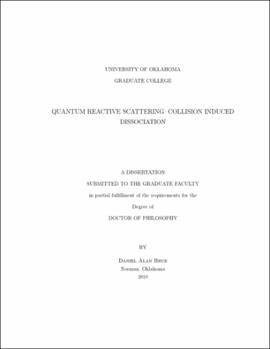| dc.contributor.advisor | Parker, Gregory A. | |
| dc.creator | Brue, Daniel Alan | |
| dc.date.accessioned | 2019-04-27T21:29:42Z | |
| dc.date.available | 2019-04-27T21:29:42Z | |
| dc.date.issued | 2010 | |
| dc.identifier | 99236493802042 | |
| dc.identifier.uri | https://hdl.handle.net/11244/318828 | |
| dc.description.abstract | A new method of generating basis functions for reactive and collision-induced dissociation | |
| dc.description.abstract | three-body scattering problems is presented. This method produces efficient, physically motivated | |
| dc.description.abstract | basis functions that are easily calculated, but most importantly are able to represent | |
| dc.description.abstract | three-body breakup states in addition to any reactive or non-reactive scattering. | |
| dc.description.abstract | An integration scheme is also presented that allows for propagation to very large distances | |
| dc.description.abstract | without increasing the required computational effort. The | |
| dc.description.abstract | methodology is presented, and basis functions for the H3 system are given as example. | |
| dc.format.extent | 175 pages | |
| dc.format.medium | application.pdf | |
| dc.language | en_US | |
| dc.relation.requires | Adobe Acrobat Reader | |
| dc.subject | Quantum scattering | |
| dc.subject | Scattering (Mathematics) | |
| dc.title | Quantum Reactive Scattering: Collision Induced Dissociation | |
| dc.type | text | |
| dc.type | document | |
| dc.thesis.degree | Ph.D. | |
| ou.group | College of Arts and Sciences::Homer L. Dodge Department of Physics and Astronomy | |
